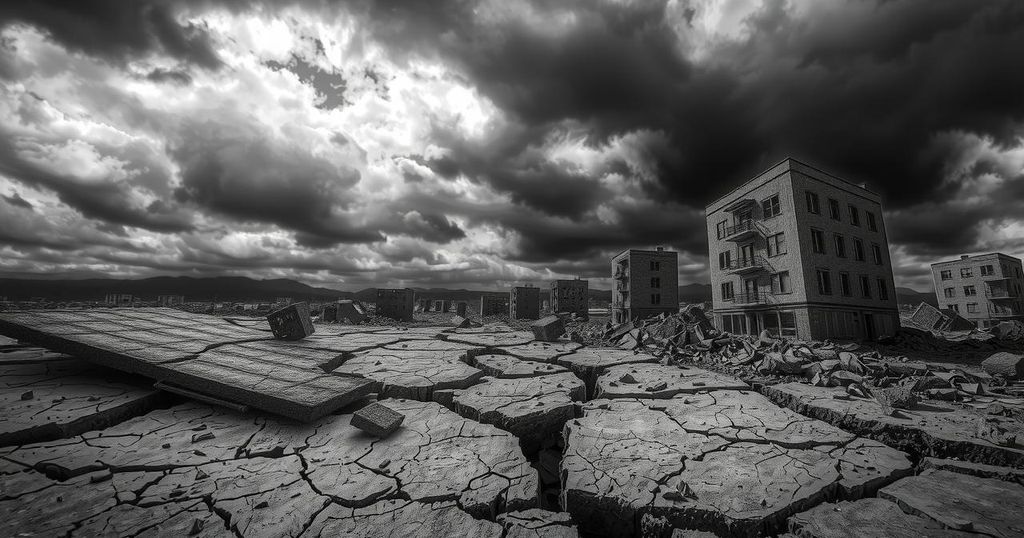World news
ASIA, AUSTRALIA, CHILE, CUBA, EARTHQUAKE, EARTHQUAKES, FUKUSHIMA, FUKUSHIMA NUCLEAR PLANT, HAWAII, INDIA, INDIAN OCEAN, JAPAN, MANDALAY, MYANMAR, NATURAL DISASTERS, NEW ZEALAND, NORTH AMERICA, OCEANIA, PHILIPPINES, SAN ANDREAS, SEISMIC ACTIVITY, SEISMOLOGY, SENDAI, SOUTH AMERICA, THAILAND, US, VALDIVIA
Oliver Grayson
0 Comments
Understanding the Potential Impact of Future Earthquakes
Myanmar’s recent earthquake serves as a reminder of the seismic risks globally, including the potential catastrophic Big One anticipated along various fault lines, particularly the Cascadia Subduction Zone. Historical records highlight major earthquakes, such as the Valdivia Earthquake of 1960 and the 2004 Indian Ocean quake. The potential for significant destruction exists in multiple regions, including the Himalayas and Marikina Valley, advocating for improved preparedness.
Recently, Myanmar experienced a powerful earthquake registering 7.7 on the Richter scale, causing significant destruction and loss of life. The tremors, felt as far as Thailand, resulted in casualties believed to be in the hundreds, with damage estimated in the billions. This event has reignited discussions about another anticipated major earthquake, often referred to as “The Big One,” the timing and exact location of which remain uncertain.
The most powerful earthquake recorded in history is the Valdivia Earthquake in Chile, which occurred on May 22, 1960, with a magnitude of 9.4-9.6. It lasted around 10 minutes and generated tsunamis that impacted various regions globally. The human toll and overall damage estimates range significantly, with deaths between 1,000 and 6,000. The Indian Ocean earthquake of 2004, measuring 9.2-9.3, remains the deadliest of the 21st century, claiming over 200,000 lives.
The term “The Big One” originated in popular culture, particularly in the United States, referencing a potential severe earthquake along the San Andreas Fault. Groundbreaking research in 1953 by geologists Mason Hill and Thomas Dibblee highlighted this fault’s capacity for substantial seismic activity, predicting earthquakes of magnitude 7-8 that could devastate major cities like Los Angeles and San Francisco. Several films have dramatized this narrative, further embedding the concept into public consciousness.
Recent geological studies suggest that what many call The Big One might instead originate from the Cascadia Subduction Zone, located north of the San Andreas Fault. This fault line could produce earthquakes ranging from 8 to 9.2 on the Richter scale, severely affecting urban regions along the U.S. West Coast. The risk encompasses major cities, including Seattle and others, populated by over five million residents.
The anticipated destruction from a Cascadia earthquake is alarming, with predictions indicating tens of thousands of casualties and millions left homeless. Experts express concerns about the inability of rescue services to respond effectively due to damaged infrastructure, such as roads and communication lines. The impact may also extend beyond the United States into Canada and other areas.
Current estimates from Oregon State University indicate a 37 percent probability of a significant earthquake occurring by 2060 in the Cascadia Subduction Zone. Historical data suggests the last major tremor in this region happened in the early 1700s, contributing to significant tsunamis in Japan. Although some view these predictions as overly dramatic, the consensus acknowledges the likelihood that a major earthquake is inevitable.
While the spotlight remains on the U.S. and The Big One, experts warn that a more catastrophic earthquake could arise in the Himalayas, potentially impacting northern India and Nepal. Dubbed The Great Himalayan Earthquake, it is estimated to reach magnitudes around 8, with possible casualty figures significantly exceeding those expected from The Big One. Additionally, the Marikina Valley fault system in the Philippines poses another threat, with a potential 7.0 magnitude quake capable of resulting in substantial loss of life. Predictions remain speculative as the seismic clock continues its silent ticking.
The recent earthquake in Myanmar has renewed concerns about seismic preparedness, particularly regarding anticipated major earthquakes like The Big One. Historical data shows that while the San Andreas Fault is known for potential devastation, newer studies suggest that the Cascadia Subduction Zone may be the true epicenter of forthcoming seismic activity. Additionally, vulnerable regions such as the Himalayas and the Marikina Valley could experience equally catastrophic earthquakes. Awareness and preparedness are essential as the probability of such disasters increases.
Original Source: indianexpress.com




Post Comment